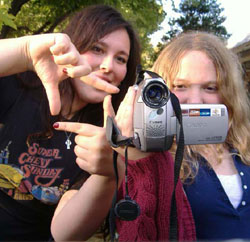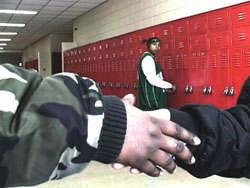
|
|
MoLLIE—The Mobile Learning Lab for Information Education in Grand Rapids, MI
 Abby Balaz demonstrates how to frame a shot. Yes, there are manuals and help-lines for the less learned adults. And I am privileged to work at one of the world’s greatest Community Technology Centers—a center completely dedicated to reaching its surrounding community through technology. The CMC provides individuals with classes along with access to the tools, training and transmission—everything they need to fulfill the CMC mission: Building Community Through Media. It only makes sense then that teaching such skills should be initiated with youth—and that's where MoLLIE comes in. Our MoLLIE team, usually consisting of two-to-five members, loads up the MoLLIE van with our equipment and heads out to the classrooms in the elementary, middle and high schools around Kent County. We take the equipment and go in, donned in our MoLLIE bowling shirts, ready to teach kids how to make TV. Over the course of one-to-four weeks, we introduce kids to technology most have never used. We equip them with digital video cameras, tripods, fish poles and boom microphones to shoot a short video they have planned and written themselves with our support. We explain how to use the equipment and let them take over. They learn how to be the talent—actors in front of the camera, as well as the crew, learning the technical aspects of being behind the camera. When writing and shooting are done, we bring in our iBooks and help them begin the exciting task of editing with iMovie, adding titles, transitions, effects, background music and finally, the credits. Within a few weeks, their movies will air on GRTV and they will get the full effect of the video-making process. Programs like MoLLIE are important for many reasons. (1) Confidence. One of my favorite things to do is to compliment kids on a job well done. Especially when I can be specific: “I like your composition,” or “You’ve got a knack for editing.” You can literally see their confidence soar. And they learn how the skills they're developing can pay off when they are older and lead to careers in the field. (2) Creative outlet. MoLLIE can make subjects like math and science more fun. The kids get to learn, create, and teach. At Crestwood Middle School, we visit the current 6th grade class twice a year. This spring I worked with two boys who made a video about humidity. I never thought humidity could be something to laugh about. When watching it, it is easy to see that the boys thoroughly enjoyed making their video, even if it was only about wetness in the atmosphere. (3) MoLLIE is a key tool for helping bridge the digital divide. As the world marches inevitably toward the infinite, blank space of this technological age, understanding technology is becoming less an option and more a necessity. Just as reading and writing are essential skills for one to have the hope of a better life, every child deserves to be at least exposed to this growing dependency on technology. It should not be reserved for only the fortunate ones who can afford it. The mobile support that MoLLIE provides helps reach those who might not otherwise be reached. (4) Finally, with MoLLIE, youth have and can learn to develop their own voice and informed perspective. Breaking down media into an accessible, step-by-step process also introduces kids to the idea of media literacy, something emphasized by GRCMC's affiliated Institute for Information Democracy. By making television themselves, youth develop an awareness of how commercial media is created and often contrived. Instead of being silent sponges, their eyes and minds will be more scrutinizing and less passive—they ultimately become more informed watchers—and having the tools to dissect media also enhances their ability to articulate the media they create on their own. This allows them another avenue for self-expression. My time here in Grand Rapids has certainly supplied me with wonderful memories, one being a quick week spent at Union High School. I rarely work with high school kids; most of our kids are middle school age. My co-worker and I walked into a small office with a group of 8-10 uninterested teenagers. I was intimidated immediately. I was used to talking to younger kids, who were happier and enthusiastic. We split the kids into two groups. I took what seemed to be more the more challenging group, half of whom were considered to be “at risk.” I watched them interact. In moments when I could have shut them down and made them listen to what I had to say, I chose not to. I let them talk. Slowly they warmed up to me and I got them to talk about issues that concerned them (i.e., teen pregnancy, drug use). They came up with the story.  Union High School student video on making good choices When I went back to Union a few months later to show the kids their project, I learned that two of our star players had dropped out of school. I was saddened to hear the news because I was looking forward to showing them their excellent work. I have to be glad that at least they had the experience and that I was able to tell them at the time how well I thought they had done. As my year with MoLLIE comes to a close, I have begun thinking about how I could possibly start a project like MoLLIE back in Oklahoma. If I have learned anything this year, it's that teaching kids technology is rewarding, fun, and important. Starting a new project like MoLLIE would be a challenge, just as spontaneously moving to Grand Rapids was—but if there was another thing I've learned this year, it’s that challenges are worth it.  Abby Balazs served as a CTC VISTA at the Grand Rapids Community Media Center for the 2004-05 program year.
Hyperlinks references in this article: Comments
|